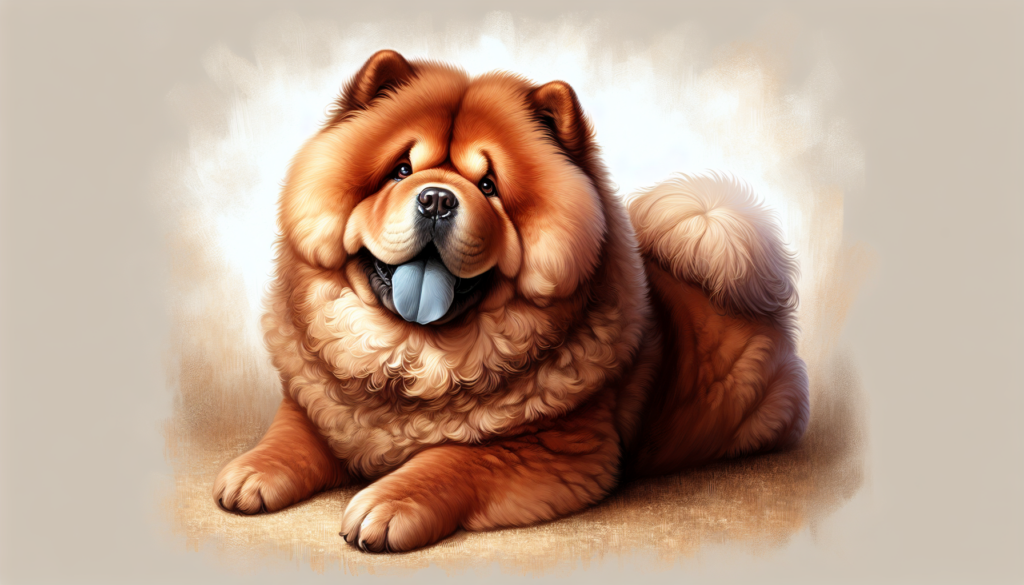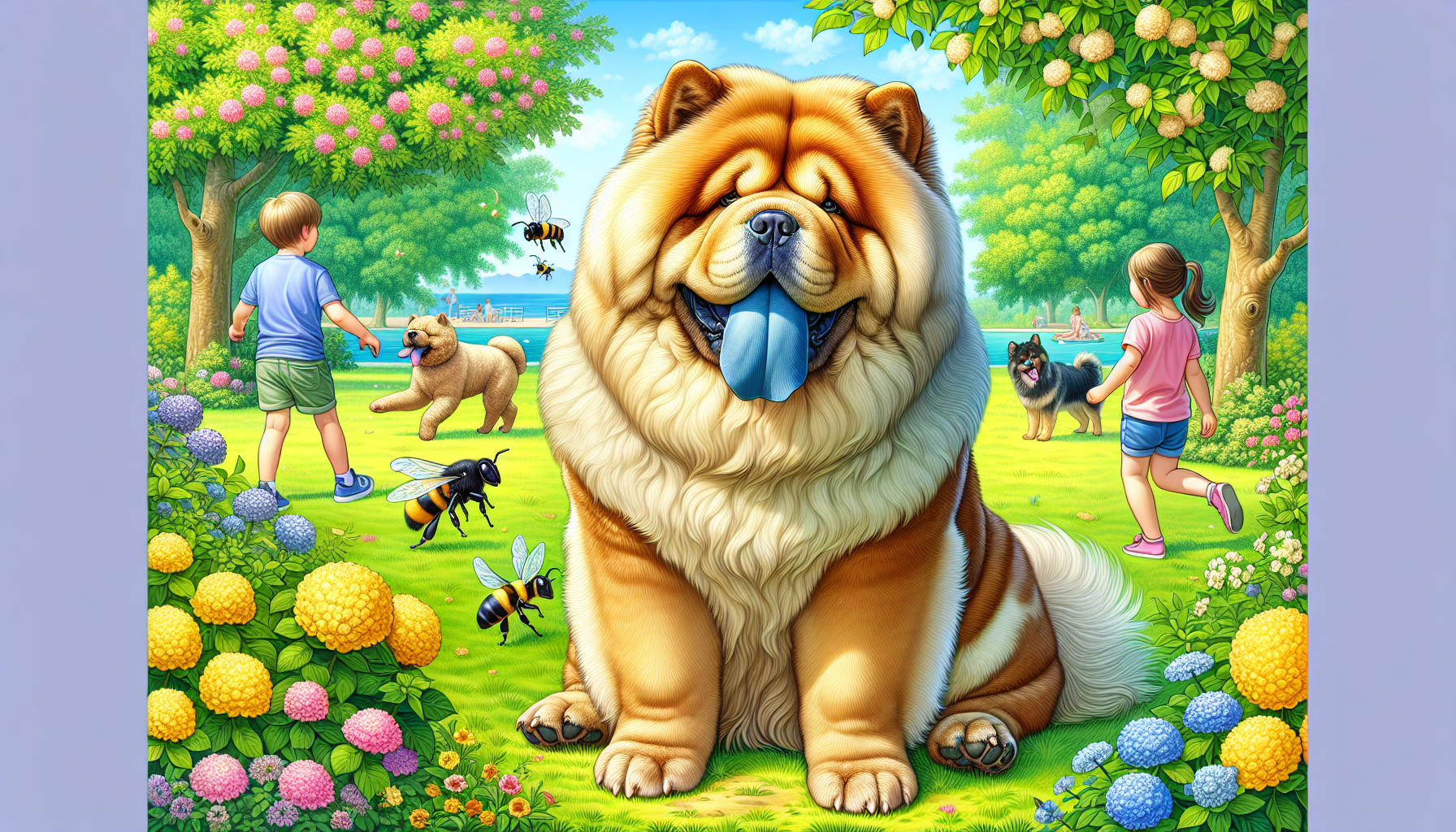Welcome to the mystery of the “Chow Chow blue tongue” conundrum! The stunning Chow Chow, one of the ancient dog breeds originated in China, with its glorious mane and its aristocratic composure, is famed for its unusual tongue color which is unique in the dog universe. Chow Chows have blue tongues, it’s a delightful quirk unique to this breed – a feature that has fascinated breeders, scientists, and Chow Chow lovers alike.
Do you want to know more about reasons why do Chow Chows have blue tongues? Then use the table of contents below to jump to the most relevant section. And you can always go back by clicking on the black arrow in the right bottom corner of the page. Also, please note that some of the links in this article may be affiliate links. For more details, check the Disclosure section at the bottom of the page.
Why Do Chow Chows Have Blue Tongues?
Technically speaking, the tongue of a Chow Chow isn’t just blue- it’s bluish-black or purple. From purebred Chow to your everyday hodgepodge of mixed breed, the color of a dog’s tongue usually range from pink to black, and sometimes feature unique pigmentation patterns. Yet, there’s something special about Chow Chows and their distinctive blue or black tongue.
Understanding the Pigmentation of Chow Chows’ Tongues
The blue tongue of a Chow Chow is due to the pigmentation similar to that of their skin. Chow chow puppies are actually born with pink tongues. But usually by eight weeks old, their tongues turn blue or black as part of their unique pigmentation process. The pigment that causes a blue or black tongue in a Chow Chow is the same pigment that causes humans to have different skin colors – it’s all about melanin. Melanocytes, the cells that produce melanin, are particularly active in Chows, resulting in their unique blue tongues.
While the American Kennel Club (AKC) indicates only a purebred Chow Chow will sport this unique blue tongue, it’s worth noting that tongues can be other colors, even among Chows. For instance, it won’t come as a shock to a breeder that some Chows may have red or pink spots on their tongues, especially if they are not purebred. What sets Chow Chow breed apart from other breeds of dogs is that it and the Shar Pei are the only breeds registered by the AKC with this trait of blue-black tongues. This makes them all the more special! So, in case you were wondering,
Are Chow Chows Born with Blue Tongues?
Now you know, they aren’t. The tongue starts out pink, and as they grow older, they graciously transition into the stunning blue or black. Partly Chow Chows and other non-Chow breeds often have spotted tongues, but a full blue or black tongue could be a sign that a dog is, in fact, partly Chow Chow.
So, if you notice a dark tongue in your adorable puppy, well, you might just have some Chow heritage to celebrate! Interestingly, Chow Chows are from the Spitz family of dogs, known for their wolf-like appearance. In fact, they resemble more the teddy-bear cuteness of a dog and a bear than the icy majesty of a wolf. Despite that, their unique blue tongue gives them a surprisingly dragon-like touch. And who doesn’t love dragons!
In the end, while we may not understand every single mystery surrounding this marvelous breed, the Chow Chow and its blue tongue, remains a fascinating and unique trait that really sets this breed apart. The tongue color of a Chow Chow is just one of those quirks that makes them extra special. I mean, who doesn’t want a pet dragon-dog-bear bundle of joy?

Are Chow Chows Born with Blue Tongues?
Did you ever notice that lollipop-blue tongue when your Chow Chow yawns? Well, it’s as fascinating as it is beautiful. The answer to the question we’ve all been asking: “Are Chow Chows born with blue tongues?” is a juicy no. Unlike polar bears or us, humans, with our tongues gossipy-pink straight out of the womb, Chow Chows arrive in the world with pink tongues too! However, after a few weeks – usually eight, give or take – their tongues start changing color as a result of pigmentation. Pigment cells step into action, dousing the tongue in a blue-black ink that’s reminiscent of the midnight sky. Thus, the dark blue tongue that is a unique characteristic of Chow Chows comes into being. ‘
Blue Tongue in Chow Chows: Myth or Fact?
Some believe that the Chow Chow’s blue tongue is as much of a myth as giraffes sipping coffee at Starbucks. Well, the naysayers couldn’t be more wrong. It’s not uncommon to come across, believe it or not, blue spots on a dog’s tongue. That being said, a full-on deep-blue tongue like the Chow’s is indeed a striking oddity and no myth. In fact, the Chow Chow isn’t the only canine species to flaunt this distinctive tongue. The Chinese Shar-Pei, one of the world’s oldest dog breeds, wears this blue-black badge with much pride too. In the canine world, these two are the only members of the exclusive “Blue tongue club”.
Examining the Different Colors of Tongues in Dog Breeds
While we’re on the subject of tongues, it’s a reasonable leap to ponder upon the different colors of tongues in dog breeds. Take the Spitz dog breeds, for instance. Many dog breeders and enthusiasts often spot pink spots on these furballs’ tongues. Does a dog’s tongue mean the dog is unwell, or exotic perhaps? Hardly! It’s normal for the pigmentation to dilute and, hence, the pink spots. Also, note that black spots on a dog’s tongue don’t always mean it’s a Chow Chow in disguise. Many breeds may have pigmented spots on their tongues and gums. It’s like their version of freckles or birthmarks.
Can Chow Chows’ Tongues Be Other Colors?
Just as spotting a unicorn would be a spectacle, finding a Chow Chow without a blue tongue would be equally astounding. However, the Chow Chow’s tongue does not always adhere to the standard blue-black. In some rare and rather exciting circumstances, Chow’s blue tongues may develop pink spots. The licking machine lying lazily in the mouth of your cuddly Chow Chow doesn’t defy nature or the breed standard. Instead, it reveals an interesting dilution in the pigmentation.
Some may raise alarms seeing pink spots on their Chow Chow’s tongue. However, that’s about as harmless as it is fascinating. Note that while the breed standard prefers a Chow Chow’s tongue to be preferably black, a spotted tongue won’t disqualify a Chow from being one of the world’s oldest and most adorable dog breeds. Keep loving those furry balls!
Comparing Blue Tongue Phenomenon in Chow Chows to Other Animal Species
When you compare the Chow Chow, a member of the Spitz family, with its lion-like body structure, to other species such as the athletic Labrador Retriever or the spirited Siberian Husky, the blue tongue phenomenon is quite unique. While this feature is something we often associate with specific breeds like the Tibetan Mastiff or the Dalmatian, it’s most prominently seen in our beloved Chow Chows. Even among species, there are very few animals besides the Chow Chow that have a blue or blue-black tongue. Giraffes, for instance, also have dark-colored tongues, which scientists speculate is to protect them from sunburn while eating.
The blue tongue, or more precisely, the bluish-black pigmentation we observe in Chow Chows, is due to extra pigmentation on the surface or edges of the tongue. Similar to how a black Lab may sport a coat of impossibly dark fur, it seems that Chow Chows and a few other breeds probably share distant ancestors with a gene for extra tongue pigmentation. This gene might trace back to the Hemicyon – an ancient bear dog known to have lived 20 million years ago.
Why is my Chow Chow’s Tongue Turning Pink?
Mama used to say there’s nothing to worry about if your Chow Chow’s tongue changes shades on occasion. Colors can vary from lavender to blue-black, and it’s entirely common for the tongue to turn back to pinkish hues from time to time. But what if the pink takes over? What could that mean? Well, while coat color can be influenced by age or the weather (we all know our Chow Chows’ fur changes from bright red to dilute colors in hot summers), a bright pink tongue is usually a sign your fluffy friend is panting hard, probably after chasing that speedy Malinois in the park. However, if it stays pink for an extended period or if your dog seems unwell, it’s time to visit your trusty veterinarian. Pink tongue could mean several things, including a lack of pigmented cells or some other health issues, and it’s best to get a vet’s opinion.
Do only chow chows have blue tongues?
While Chow Chows appear to corner the market on the blue tongue phenomenon, they aren’t the only breed that can boast of this unique trait. In the canine world, a cousin to the Chow Chow, the Chinese Shar-pei, also sports a blue tongue, thanks to its 44 teeth and hefty dose of pigmented cells. But beyond dogs, other members of the animal kingdom also parading their blue tongues, including the giraffe and several species of bear – most notably the polar bear. In the 1820s, the first Chow Chow appearing at the London Zoo had such a tongue-popping blue-black coloring that spectators were awestruck by this unique oddity of nature. But in truth, as exotic as a blue tongue may seem, we know it’s just another loveable quirk in an array of remarkable features that define our favorite fuzzy companions, whether they’re a terrier, a shepherd, or a proud, lion-like Chow Chow.
Thanks for the blog graphics: Canva.com
Doghint.com is a participant of several affiliate programs. The list includes (but not limited to) the following: VigLink, Refersion, ShareASale, and Amazon Services LLC Associates Program, an affiliate advertising program designed to provide a mean for us to earn fees by linking to Amazon.com and affiliated sites. Doghint.com does not intend to provide veterinary advice. All published articles are meant for informational purposes only and not substitute the professional veterinary consultation.


